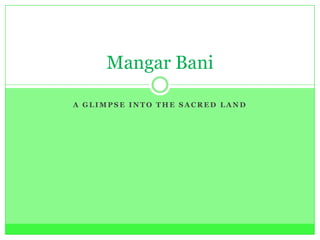
Mangarbani: Delhi’s last sacred forest grove
- 1. A G L I M P S E I N T O T H E S A C R E D L A N D Mangar Bani
- 2. Mangar Bani is Delhi’s last sacred forest grove. Bani means forest and Mangar is the name of the village where it is located. Mangar Bani literally means the forest of villagers of Mangar. Seen here: A roadside sign on the Gurgaon- Faridabad highway for the Bani Dham temple. People from various parts of Delhi-NCR visit the temple of the local legend of Gudariya Baba whose soul, people believe, still exists in the forest.
- 3. Located near one of the oldest mountain ranges in the world, The Aravalis, Mangar Bani is fighting a battle for its existence as Delhi’s last water recharge zone. In this pic: A view of the Aravalli hills from the Government High School, Mangar, Faridabad. Illegal mining in the Aravallis has deprecated the water table in the NCR region tremendously .
- 4. The Bani Dham temple where the deity of Gudariya Baba is worshipped by not just the local Gujjar community but people from other regions of Delhi as well. It is believed that Gudariya Baba vanished in a cave inside this temple.
- 5. The Mangar village has an approximate population of 5000 people. According to one of the village locals Gajraj (seen smoking the pipe in this pic), men in Mangar smoke the hookah and socialize on a daily basis as there are no major forms of recreation.
- 6. A usual day in Mangar Bani lasts approximately from 3 am to 6 pm. People usually sleep early, on most days before 8pm. In this pic, villagers enjoy a peaceful sleep on charpoys in their verandahs. Though electricity reaches almost all households in Mangar, it is disturbed by long hours of indefinite load shedding.
- 7. Dinner is served quite early in the evening in the village, usually around 5 pm. The women of the household serve hot chapatis to male family members gathered around the earthen stove. The household tasks are usually performed by the women.
- 8. Local women cover their heads with a duppatta as a sign of paying respect to the elderly and to their husbands. Marriage for girls usually takes place at the age of 18-20. In this pic, from left t right.
- 9. A young girl from Mangar village flips through her painting. The state of education in the village is quite dismal and there is a dearth of teaching staff at the local school.
- 10. Many local committees as well as NGOs have extended a helping hand to the people of Mangar village. Seen here, local women engaged in a small initiative taken by an NGO wherein they are helping to crush spices and grains. Whether or not they would be paid is yet to be decided as it is a relatively recent initiative.
- 11. Young men in Mangar sitting idle on a charpoy. Majority of the youth there do not have a stable form of livelihood and hence many support the decision of real estate development in the region.
- 12. Like the local legend of Gudariya Baba, there are many other stories of local legends and mystics that have been a part of the local folk lore. Seen in the pic, the white horse of a local mystic in Mangar village who is greatly revered by the villagers.
- 13. A heron inside the MangarBani forest. The forest is known for its rich flora and fauna. Various species that are not spotted elsewhere in the country have been seen here like the black eagle.
- 14. Despite various protests by some local committees as well as NGOs, construction activity has been allowed in Mangar Bani. During one such period a few years ago, the Arts and Crafts hotel was constructed there. Many villagers thought it might be a source of livelihood for them but they just employed one local villager. Today, it stands lonely without a signage.
- 15. Eleven-year old Ajay spends the day taking care of his flock of almost 100 goats. The rural Gujjar community relies heavily on livestock for their daily bread and butter.
- 16. A view of the forest from Gudariya Baba’s shrine. The Dhau tree dominates the green cover and grows laterally if grazed by cattle. The entire forest is made up of a single DNA from an ancient Dhau tree. It is believed that the forest has a soul of its own and it would bring wrath upon anyone who tries to destroy it.